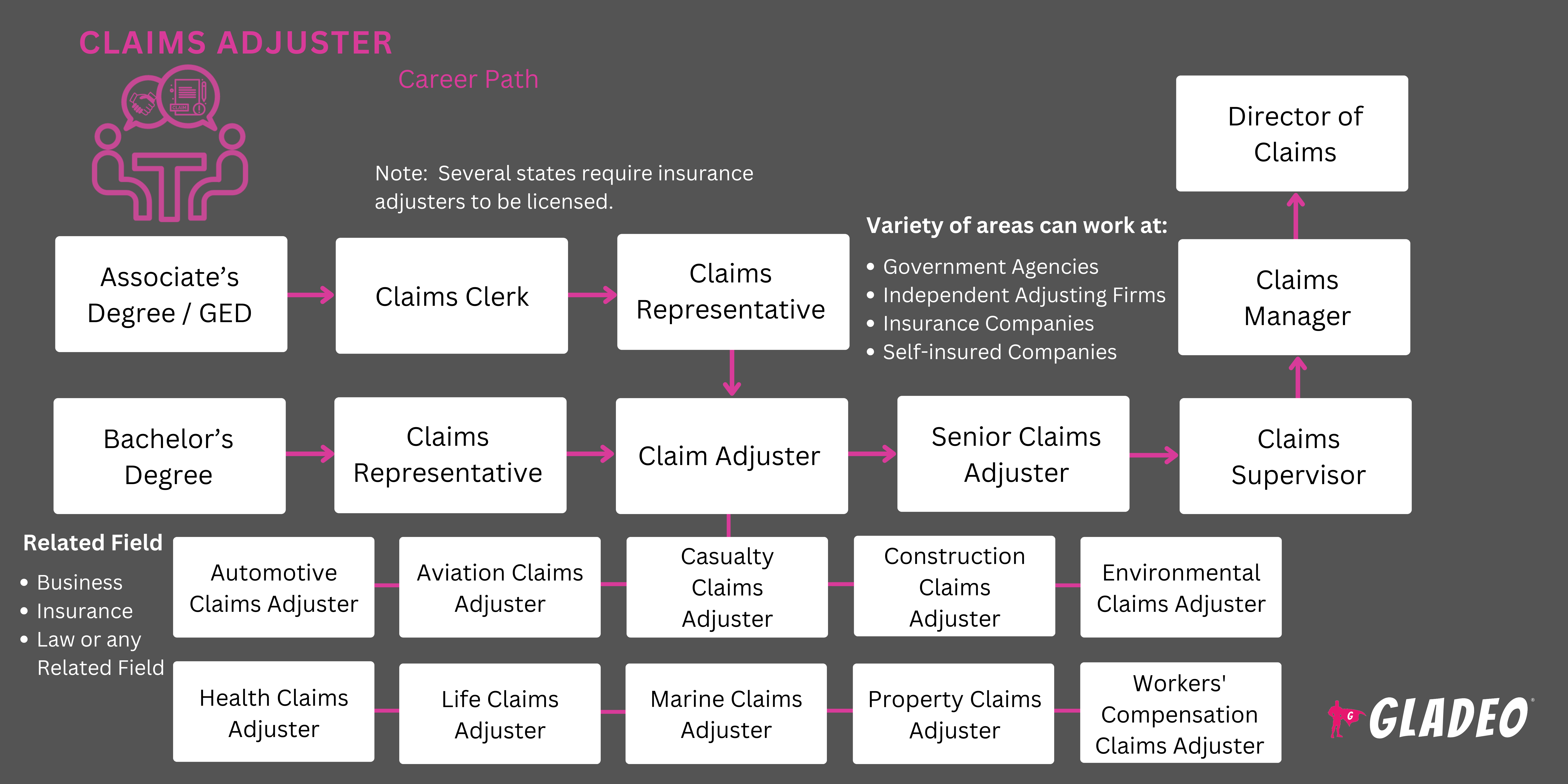Mga spotlight
Claim Adjuster, Claims Analyst, Claim Examiner, Claims Representative, Claims Specialist, Corporate Claims Examiner, Field Claims Adjuster, General Adjuster, Home Office Claims Specialist, Litigation Claims Representative
Ang insurance ay isa sa mga bagay na ayaw naming bayaran...hanggang sa kailangan namin ito!
Nakakatulong ang mga patakaran sa insurance na masakop ang mga gastos kapag dumaranas tayo ng mahihirap na sitwasyon, gaya ng aksidente sa sasakyan, pagkasira ng ari-arian, pagnanakaw, o pagkamatay sa pamilya. Sa ganitong mga kaganapan, kadalasan ay maaari kaming maghain ng claim kung mayroon kaming tamang insurance coverage.
Ngunit ang mga kompanya ng seguro ay hindi lamang nagbabayad ng mga paghahabol nang hindi muna tinitingnan ang mga ito. Nagtatalaga sila ng Claims Adjuster upang makipagtulungan nang malapit sa may-ari ng insurance policy upang masuri ang claim at matukoy ang naaangkop na payout, kung kinakailangan.
Ang mga Claim Adjusters ay karaniwang nagtatrabaho o kinokontrata ng provider ng insurance. Kaya, kahit na nagtatrabaho sila upang tulungan ang mga claimant, dapat din nilang tingnan ang pinakamahusay na interes ng kanilang mga employer. Iyon ang dahilan kung bakit bahagi ng kanilang trabaho ang mag-imbestiga sa mga posibleng mapanlinlang na claim. Ang kanilang trabaho ay mahalaga sa pagtulong sa mga indibidwal at negosyo na makabangon mula sa hindi inaasahang pagkalugi habang tinitiyak din ang pagiging patas sa mga kompanya ng seguro.
- Pagtitiyak ng patas, mahusay na mga resolusyon sa paghahabol
- Pagtulong sa mga indibidwal at negosyo na makabangon mula sa pagkalugi
- Patuloy na pagkakaiba-iba sa pagkuha sa iba't ibang mga claim
Oras ng trabaho
- Ang mga Claim Adjusters ay nagtatrabaho ng karaniwang 40-oras na linggo ngunit maaaring kailanganing magtrabaho ng obertaym sa panahon ng mga natural na sakuna o mataas na panahon ng paghahabol. Maaaring kabilang sa tungkulin ang parehong opisina at fieldwork, na nangangailangan ng paglalakbay upang siyasatin ang mga pinsala mismo.
Mga Karaniwang Tungkulin
- Suriin ang mga claim at patakaran ng mga claimant upang matukoy ang mga tuntunin at halaga ng saklaw
- I-verify ang pagmamay-ari ng nasira o ninakaw na ari-arian. I-verify ang mga talaan ng trabaho ng naghahabol, kapag naaangkop
- Gabayan ang mga may hawak ng patakaran sa proseso ng pag-claim
- Interbyuhin ang mga claimant at testigo. Kumonsulta sa mga rekord ng pulisya at ospital, kung kinakailangan
- Suriin ang pinsala sa ari-arian o mga claim sa personal na pinsala upang matukoy ang pananagutan ng kompanya ng seguro
- Makipagtulungan sa mga kontratista, repairer, at medikal na propesyonal upang mangalap ng impormasyon tungkol sa lawak ng mga pinsala at mga pagtatantya ng gastos para sa pag-aayos o paggamot
- Iwasto ang anumang mga error o pagtanggal sa form ng paghahabol
- Suriin ang mga natuklasan at idokumento ang mga proseso ng pagsisiyasat. Iulat ang mga natuklasan at rekomendasyon sa kompanya ng seguro
- Makipag-ayos sa mga naghahabol habang kinakatawan ang kompanya ng seguro
- Mag-isyu o pahintulutan ang mga pagbabayad sa mga naghahabol, kung naaangkop
- Panatilihin ang mga talaan ng mga claim sa mga computer system. Iulat ang mga status ng claim sa pamamahala ng kumpanya
- Makipagtulungan sa mga abogado sa mga claim na nangangailangan ng paglilitis o legal na kadalubhasaan. Magtipon at magdokumento ng ebidensya upang suportahan ang mga pinagtatalunang claim
- Kinakatawan ang mga kompanya ng seguro sa panahon ng mga pagsubok o pamamagitan
- Suriin ang legal na pagsingil para matiyak ang cost-effective na paghawak ng mga claim
Karagdagang Pananagutan
- Maghanap ng mga palatandaan ng panloloko sa insurance sa pamamagitan ng mga pagsisiyasat at mga diskarte sa pagtuklas ng panloloko
- I-refer ang mga claim na nangangailangan ng karagdagang pagsisiyasat sa mga espesyal na investigator o adjuster
- Tukuyin at iulat ang mga pagkakaiba sa pananalapi (tulad ng mga sobrang bayad o kulang sa pagbabayad)
- Magrekomenda ng mga pagsasaayos sa reserba ng mga claim ng kumpanya (ibig sabihin, ang mga pondong nakalaan upang bayaran ang mga paghahabol sa hinaharap)
- Makilahok sa mga pulong ng komite
- Manatiling may kaalaman tungkol sa mga bagong patakaran sa insurance, batas, at teknolohiya
- Network sa mga propesyonal sa insurance, abogado, at mga kasosyo sa industriya
Soft Skills
- Analitikal na pag-iisip
- Aktibong pakikinig
- Malinaw na komunikasyon
- Pagsunod-orientation
- Pag-ayos ng gulo
- Kritikal na pag-iisip
- Serbisyo sa customer
- Paggawa ng desisyon
- Mabusisi pagdating sa detalye
- Integridad
- Pagsubaybay
- Negosasyon
- Pagtugon sa suliranin
- Mga relasyon sa publiko
- Pagtutulungan ng magkakasama
- Pamamahala ng oras
Teknikal na kasanayan
- Kahusayan sa pagbibigay-kahulugan sa mga patakaran at saklaw ng insurance
- Pag-unawa sa mga prinsipyo ng paghawak at pag-aayos ng mga claim sa seguro
- Malawak na kaalaman sa konstruksyon, automotive repair, o iba pang nauugnay na teknikal na larangan upang tumpak na masuri ang mga pinsala
- Pamilyar sa legal, medikal, at terminolohiya sa gastos sa pagkukumpuni
- Paggamit ng software sa pamamahala ng mga paghahabol at mga database
- Kaalaman sa mga diskarte at kasanayan sa pagtuklas ng pandaraya
- Mga tindahan ng pagkumpuni ng sasakyan at mga kumpanya ng konstruksiyon
- Mga serbisyo ng seguro ng gobyerno
- Mga kumpanyang nagsasaayos ng mga independiyenteng claim
- Mga kompanya ng seguro
- Mga legal na kumpanya na nag-specialize sa mga claim sa insurance
Kapag ang isang tao ay nag-file ng isang claim sa seguro, kadalasan ito ay dahil sa isang bagay na masama, marahil kahit na trahedya, ay nangyari sa kanilang buhay. Ang mga Claim Adjusters ay dapat na handa na pangasiwaan ang mga emosyonal na sitwasyon na may empatiya at propesyonalismo.
Kasabay nito, kailangan nilang maging layunin at analytical pagdating sa pagrepaso sa claim at pagsunod sa mga tuntunin ng patakaran sa seguro. Maaaring hindi magbayad ang ilang claim ayon sa gusto ng naghahabol. Ang ilang mga kaso ay maaaring kailanganing litigasyon upang malutas ang mga ito. Samantala, kasing dami ng 20% ng mga claim ang maaaring ituring na mapanlinlang at dapat imbestigahan.
Ang mga Claim Adjusters ay dapat na mga eksperto sa paksa na pamilyar sa isang malawak na hanay ng mga paksang nauugnay sa paghahabol, tulad ng mga pagtatantya ng pinsala sa ari-arian, average na gastos sa pag-aayos ng sasakyan, karaniwang mga halaga ng medikal na pagsingil, atbp. Dapat din silang manatiling up-to-date sa umuusbong na insurance batas, patakaran, at teknolohiya.
Ang kanilang trabaho ay maaaring tumaas nang malaki pagkatapos ng isang malaking aksidente o natural na sakuna. Maaari itong magdagdag ng malaking presyon upang gumana nang mabilis at tumpak upang malutas ang mga claim habang naghihintay ang mga naghahabol, kadalasan nang walang pasensya, upang makatanggap ng payout para sa mga pagkalugi na kanilang naranasan.
Nakakatulong ang mga bagong teknolohiya na i-streamline ang proseso ng mga claim, na ginagawa itong mas mabilis at mas mahusay. Magandang balita iyon para sa mga Claim Adjusters, maliban sa isang bagay—ang tumaas na kahusayan ay nakakaapekto sa paglago ng trabaho sa propesyon na ito. Ayon sa Bureau of Labor Statistics, ang kabuuang trabaho sa larangang ito ay inaasahang bababa ng 3% sa darating na dekada.
Iyon ay sinabi, ang mga pagbabago sa kapaligiran ay tila tumataas ang dalas ng mga natural na sakuna na maaaring humantong sa pinsala sa ari-arian at, sa turn, mga claim sa seguro. Ang mga kompanya ng seguro ay malinaw na hindi kayang magbayad ng higit pa sa mga claim kaysa sa kanilang kinikita mula sa mga premium ng patakaran (ang halagang binabayaran sa kanila bawat buwan upang panatilihing aktibo ang isang patakaran sa seguro). Iyon ang dahilan kung bakit sila nagpapatakbo gamit ang mga pagtatasa ng panganib na umaasa sa mga hula batay sa posibilidad!
Halimbawa, ang posibilidad ng pagtama ng Earth ng isang malaking asteroid sa anumang partikular na taon ay humigit-kumulang 1 sa 500,000. Batay sa mga posibilidad na iyon, ang posibilidad na mapanatili ang pinsalang nauugnay sa asteroid ay tila medyo mababa. Maaaring makatuwirang hulaan ng isang kompanya ng seguro na walang malalaking asteroid ang tatama sa taong ito, at sa gayon ay handang magbigay ng saklaw.
Ngunit kapag ang mga bagay ay naging hindi mahuhulaan o ang posibilidad ng isang kaganapan ay nagiging mas malamang, ang mga kumpanya ay maaaring mag-alinlangan na mag-alok ng saklaw. Sa katunayan, sinabi ng Renewing America na ang isang "2021 na survey ng mga tagapamahala ng panganib sa seguro ay natagpuan na 60 porsiyento ang natatakot na ang pagbabago ng klima ay gagawing hindi masiguro ang ilang mga heyograpikong lugar." Dahil sa mga isyung ito, gumagamit ang mga insurer ng predictive analytics upang mahulaan ang mga trend ng claim sa hinaharap batay sa mga pagbabago sa kapaligiran.
Ang mga indibidwal na naakit sa isang karera bilang isang Claims Adjuster ay maaaring nasiyahan sa mga aktibidad sa paglutas ng problema o pagtulong sa iba sa mahihirap na sitwasyon. Maaaring na-intriga din sila sa mga proseso ng pagsisiyasat at may kakayahan para sa mga gawaing nakatuon sa detalye!
- Ang pagiging isang Claim Adjuster ay nangangailangan ng pinaghalong edukasyon, nauugnay na karanasan sa trabaho, at sertipikasyon
- Ang ilang mga posisyon ay nangangailangan ng bachelor's degree na may major sa risk management at insurance, business administration, finance, o isang kaugnay na lugar, ngunit maraming entry-level na tungkulin ang tumatanggap ng mga kandidato na may diploma sa high school o katumbas at sapat na nauugnay na karanasan sa trabaho sa insurance
- Bawat O*Net , humigit-kumulang 56% ng Claims Adjusters ang mayroong bachelor's
- Maaaring kabilang sa mga karaniwang paksa ng kurso sa kolehiyo ang:
- Batas sa Negosyo
- Etika sa Insurance
- Financial Accounting
- Mga Prinsipyo ng Seguro
- Insurance sa Ari-arian at Kaswalti
- Pamamahala ng Panganib
- Kasama sa mga opsyon sa sertipikasyon ang:
- AACE International, Inc. - Certified Forensic Claims Consultant
- Kredensyal ng Association of Certified Fraud Examiners
- Insurance Data Management Association - Associate Insurance Data Manager
- Insurance Regulatory Examiners Society - Accredited Insurance Examiner
- International Association of Special Investigation Units - Certified Insurance Fraud Investigator
- International Claim Association - Associate, Life and Health Claims
- Society of Financial Examiners - Automated Examination Specialists
- Ang mga Institusyon -
* Associate sa National Flood Insurance
* Associate sa Regulasyon at Pagsunod
* Certified Claims Professional
- Karamihan sa mga kompanya ng seguro ay magbibigay ng isang tiyak na halaga ng On-the-Job na pagsasanay, na may ilang mga employer na handang magbigay ng higit pa kaysa sa iba!
- Ang ilang mga estado ay nangangailangan ng mga tagapag-ayos na magkaroon ng isang lisensya, ngunit ang ibang mga estado ay nagpapahintulot sa kanila na magtrabaho sa ilalim ng lisensya ng kanilang kumpanyang nagtatrabaho.
- Ang isang lisensya ay maaaring mangailangan ng 40 oras ng pagsasanay sa paunang paglilisensya, bagaman ang ilang mga estado ay nangangailangan lamang na ang mga kandidato ay makatanggap ng isang nakapasa na marka sa isang pagsusulit sa paglilisensya
- Ang National Insurance Producer Registry ay nagbibigay ng impormasyon tungkol sa mga kinakailangan sa paglilisensya ng estado
- Ang mga kandidatong interesado sa pagpupursige ng karera sa pagsasaayos ng mga claim ay dapat maghanap ng mga unibersidad na nag-aalok ng matibay na programa sa negosyo, pangangasiwa ng negosyo, pananalapi, pamamahala sa peligro, o insurance
- Maghanap ng mga programang nag-aalok ng hands-on na karanasan o mga pagkakataon para sa mga internship sa mga kompanya ng seguro
- Isaalang-alang ang halaga ng matrikula, mga diskwento, at mga pagkakataon sa lokal na iskolarship (bilang karagdagan sa tulong na pederal sa pamamagitan ng FAFSA )
- Sa high school, mag-aral ng mabuti sa math, business, at economics courses
- Paunlarin ang iyong mga kasanayan sa pagsulat at pandiwang komunikasyon
- Maghanap ng mga internship o part-time na trabaho sa mga kompanya ng seguro upang makakuha ng nauugnay na karanasan
- Sumali sa mga business o finance club para matuto pa tungkol sa industriya
- Pumunta sa mga seminar at workshop tungkol sa insurance, pagpoproseso ng mga claim, at serbisyo sa customer
- Ituloy ang isang kaugnay na major sa kolehiyo tulad ng risk management at insurance o business administration
- Maghanap ng mga pagkakataon sa iskolarship na nauugnay sa insurance, tulad ng iniaalok ng Association of Insurance Compliance Professionals
- Subukang tukuyin kung aling uri ng insurance ang gusto mong pagtuunan ng pansin, para matuto ka pa tungkol sa mga nauugnay na paksa
- Halimbawa, kung gusto mong magtrabaho kasama ang mga medikal na claim, maaaring makatulong na matutunan ang tungkol sa medikal na pagsingil, coding, at karaniwang mga gastos
- Kung nagtatrabaho ka sa mga auto claim, maaari mong malaman ang tungkol sa mga auto repair shop at karaniwang mga gastos para sa repair work
- Maaaring madaling gamitin ang mga kursong legal kung gagawa ka sa pananagutan o mga paghahabol sa kompensasyon ng manggagawa
- Tukuyin ang mga kinakailangan sa paglilisensya ng iyong estado, kung mayroon man. Kumuha ng kursong paghahanda o bumili ng mga materyales para sa pag-aaral sa sarili upang magtagumpay ka sa pagsusulit!
- Sumali sa mga propesyonal na organisasyon tulad ng International Claim Association o The Institutes sa network at makisali sa propesyonal na pag-unlad
- Kumuha ng mga naaangkop na certification sa pamamagitan ng mga organisasyon gaya ng AACE International, Insurance Data Management Association, International Claim Association, o The Institutes

- Tandaan na ang ilang estado ay nangangailangan ng lisensya. Gayunpaman, ang mga employer ay madalas na handang kumuha ng mga adjuster na hindi pa nakakakuha ng kanilang lisensya, at maaaring makatulong sa kanila na maghanda para sa kanilang mga pagsusulit!
- I-scan ang mga pag-post ng trabaho sa mga portal tulad ng Indeed at Glassdoor , pati na rin ang Craigslist para sa mas maliliit na lokal na trabaho
- Humingi ng tulong sa career counselor o service center ng iyong paaralan sa paghahanap ng mga internship at job fair, at para sa paghahanda ng mga resume at pagsasagawa ng mga kunwaring panayam
- Makipag-ugnayan sa mga propesyonal sa industriya ng seguro hangga't maaari. Maraming trabaho ang nakikita pa rin sa pamamagitan ng bibig
- Ihanda ang iyong resume upang i-highlight ang lahat ng nauugnay na karanasan, edukasyon, at kasanayan
- Tingnan ang mga halimbawa ng mga resume ng Claim Adjuster para sa mga ideya. Isama ang mga keyword tulad ng:
- Pagsisiyasat sa Mga Claim
- Software sa Pagproseso ng Mga Claim
- Serbisyo sa Customer
- Pagtatasa ng Pinsala
- Dokumentasyon at Pag-uulat
- Pagtuklas ng Panloloko
- Pagsusuri ng Patakaran
- Pagsunod sa Regulasyon
- Pamamahala ng Panganib
- Settlement Negotiation
- I-highlight ang iyong kakayahang pag-aralan ang impormasyon, lutasin ang mga problema, at epektibong makipag-usap
- Magsanay para sa mga panayam sa pamamagitan ng pagrepaso sa mga karaniwang tanong sa panayam ng Claims Adjuster gaya ng "Paano mo mabisang matutukoy ang saklaw ng insurance?"
- Maghanda para sa mga panayam sa pamamagitan ng pagsasaliksik sa website ng hiring organization upang malaman ang tungkol sa kanilang misyon at mga karaniwang kliyente
- Kung bibigyan ng mga pangalan ng mga taong mag-iinterbyu sa iyo, hanapin ang kanilang mga propesyonal na talambuhay upang matuto nang kaunti tungkol sa kanila
- Manatiling may kaalaman tungkol sa kasalukuyang mga uso sa industriya, mga pag-unlad, at mga bagong terminolohiya
- Ito ay tumatagal ng hindi bababa sa ilang taon ng ipinakitang mataas na kalidad na pagganap ng trabaho upang umakyat sa mga ranggo
- Para sa bawat promosyon o pagsulong na natanggap, asahan ang hindi bababa sa dalawang taon ng matatag na trabaho pati na rin ang karagdagang edukasyon at pagsasanay upang maabot ang susunod na antas
- Makipag-usap sa iyong superbisor tungkol sa pag-unlad ng karera. Magtanong tungkol sa kung aling mga lugar ang maaari mong pag-aralan nang higit pa upang pinakamahusay na makapaglingkod sa kumpanya. Ipaalam sa iyong tagapag-empleyo na handa kang sumailalim sa mga karagdagang kurso sa pagsasanay upang mapahusay ang iyong mga kasanayan
- Ituloy ang mga karagdagang certification sa mga lugar na may mataas na demand o mahirap punan na mga niches, kung kailangan ng iyong kumpanya. Tanungin ang iyong tagapag-empleyo kung handa silang sagutin ang mga gastos sa matrikula o pagsusulit
- Hilingin na pangasiwaan ang mas kumplikadong mga paghahabol o pamahalaan ang mga proyektong nangangailangan ng mga kasanayan sa pamumuno
- Kung kinakailangan upang mag-advance, isaalang-alang ang pag-aplay sa ibang kumpanya kung makakita ka ng pagbubukas ng trabaho
- Maging maagap sa loob ng mga propesyonal na organisasyon tulad ng American Planning Association . Palakihin ang iyong reputasyon at katayuan sa loob ng industriya sa pamamagitan ng paglalahad ng mga talumpati o pag-publish ng mga piraso ng pamumuno ng kaisipan
- Isaalang-alang ang pagkakaroon ng graduate degree sa negosyo. Maaari kang maging kwalipikado para sa mga posisyon sa pamamahala
- Humingi ng isang tagapayo para sa gabay at propesyonal na pag-unlad
- Manatiling may kaalaman tungkol sa mga uso sa industriya at mga inobasyon sa pamamagitan ng pagbabasa ng mga balita sa industriya at pakikilahok sa mga grupo ng talakayan
Mga website
- AACE International, Inc.
- American Property Casualty Insurance Association
- Kapisanan ng mga Certified Fraud Examiner
- Alyansa sa Pamamahala ng Mga Claim at Litigation
- Asosasyon ng Pamamahala ng Data ng Seguro
- Insurance Regulatory Examiners Society
- International Association of Special Investigation Units
- International Claim Association
- Loss Executives Association
- National Association of Independent Insurance Adjusters
- Pambansang Samahan ng mga Komisyoner ng Seguro
- National Association of Public Insurance Adjusters
- National Insurance Crime Bureau
- National Insurance Producer Registry
- National Society of Professional Insurance Investigators
- Society of Chartered Property at Casualty Underwriters
- Society of Claim Law Associates
- Lipunan ng mga Financial Examiner
- Lipunan ng mga Rehistradong Propesyonal na Tagapagsasaayos
- Ang mga Institusyon
- Mga Propesyonal sa Paghahabol sa Kabayaran ng mga Manggagawa
Mga libro
- Pagsasaayos sa isang Career sa Property & Casualty Claims , ni Chris Casaleggio
- Ang Proseso ng Pagtatasa: Paglutas ng Mga Pinagtatalunang Claim sa Seguro , ni John A. Voelpel, III
- The New Insurance Claim Adjuster Study Guide 2024-2025 Most Comprehensive Exam Prep for All 50-State Certification , nina Phil Cirone at Richard Freeman
Ang mga Claim Adjusters ay gumaganap ng isang pangunahing papel sa industriya ng seguro, ngunit ito ay madalas na isang mahirap at kung minsan ay pinagtatalunan na trabaho. Kapag ang mga may hawak ng patakaran ay nakakaranas ng mga pagkalugi, karaniwan nilang kinakaharap ang ilang emosyonal na kaguluhan. Na maaaring mahirap makipagtulungan sa kanila, lalo na kapag hindi naaprubahan ang kanilang mga claim. Kung gusto mong malaman ang tungkol sa mga kaugnay na trabaho na nangangailangan ng mga katulad na hanay ng kasanayan, isaalang-alang ang mga opsyon sa ibaba!
- Inspektor ng Konstruksyon at Gusali
- Estimator ng Gastos
- Customer Service Representative
- Direktor sa Pamamahala ng Emergency
- Inspektor ng Sunog
- Imbestigador ng Panloloko
- Ahente ng Seguro o Broker
- Underwriter ng Seguro
- Legal Assistant o Paralegal
- Espesyalista sa Loss Control
- Tagasuri ng Ari-arian
- Tagapamahala ng Panganib
Newsfeed

Mga Tampok na Trabaho

Mga Online na Kurso at Tool








